One of the inexpensive ones, but effective ways provide yourself with early vegetables, berries, herbs from early spring to late autumn - a greenhouse made of polypropylene pipes, you can build a structure with your own hands in 1-2 days. The product is light, strong, mobile, durable, does not require significant costs and skills in construction, and can be easily dismantled if necessary.
Using HDPE pipes to make a greenhouse on a concrete foundation
It is made of unplasticized polyvinyl chloride. The characteristics of this material are high mechanical strength, tensile, bending and discoloration. The advantage of this solution is protection against splashing water even in heavy rainfall. Drainage holes and gutter connectors are equipped with special side handles that ensure the front panel is permanently secured. Does the rigid fixation of these elements make the gutter system much more stable once installed? the only element that can move, for example due to thermal changes, is the groove.
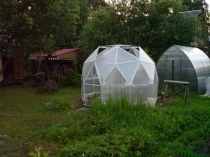

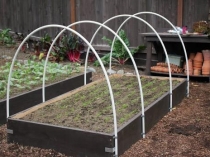
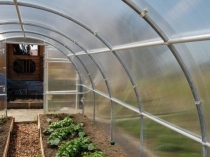

The connectors are equipped with gaskets, which increases the tightness of the system. The gutter connector has assembly lines marked with temperature. They indicate where the gutter should be located depending on the temperature prevailing during assembly. This solution makes it easier correct installation gutter seals even at high temperatures.
Polypropylene greenhouse
The connection of the gutter with the drainage pipe is ensured by the most modern threshold system. Thanks to them, it pours out of the gutter through the thresholds, mechanically stops and flows naturally into the sewer. High strength hooks stabilize the system, especially in winter when snow falls and falls from the roof.
Secrets of building greenhouses from PVC pipes
Greenhouses made from PVC profiles can be built in any shape:
- arched;
- rectangular under a single- or gable roof;
- combined from several sections;
- rectangular buildings with an arched roof.
The design depends on the preferences of the owners and the chosen project. It is important to remember that the more mates, the more connecting elements will be required, which leads to additional costs. It is advisable to arrange structures of small and medium size, 2-2.4 m high, about 3 m wide, 4-12 m long.
During assembly, the hooks are installed first, and only after the gowns are installed, the gutters themselves. This sequence of steps influences the efficiency and ease of installation and prevents damage to gutter components during roofing. A fall while covering the tool and the tile cover cannot damage the gutter.
Therefore no specialized equipment is required, although it is recommended that gutter installation be done by a professional roofing company. The most popular 132mm system? They value markets very much and they are very successful in their practice.
Suitable for the construction of greenhouses water pipes pvc, standard diameter 16-110 mm, pipe length is usually 5 m, you can buy the product in cuts: 2,3,4 m. PVC pipes with a reinforced layer of thin aluminum or a mixture of fiberglass and polypropylene are also on sale. They are more durable, but the price is higher; the use of such products for the construction of greenhouses is not economically justified, but the owner is a gentleman.
Rooftops allow you to escape from the roof of a building. Like floodlights, they also serve to illuminate rooms with natural light. Roofing coverings can be square or rectangular with galvanized or painted steel construction. The roof hatch infill is made of polycarbonate cladding panel of any color and thickness.
The following drives can be used to control sheet opening. Basic thermal insulation foundation gutter base frame open frame pressure plate polycarbonate gas spring gas spring bracket frame holder. 1.5mm thick galvanized steel straight base, 300mm base height, bottom base with mounting flange, 50mm thick thermal insulation space, drain pan for drainage, closed section steel structure, filling the door with 10mm thick double chamber polycarbonate panel. You can make a gap of any size.
The optimal polyethylene pipe for a greenhouse has a diameter of 25-32 mm for arched products, 50 or more mm for vertical supports in rectangular structures.
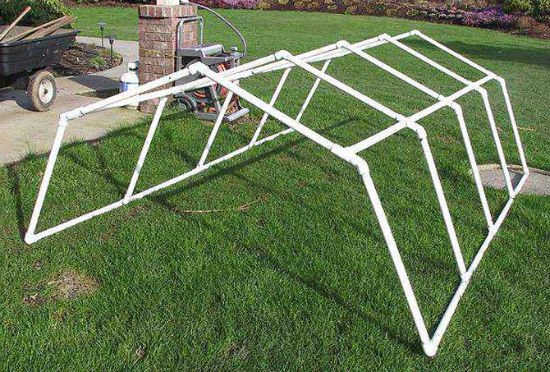
Homemade greenhouse made of polypropylene pipes, suitable for summer cottages
You can make a base of any size. You can create a base of any height. The base flange can be made to any width. You can increase the width of the space remaining after heating. You can use polycarbonate boards of any available thickness. External and closed door curtains in warehouses Curtains in cold storage rooms, processing plants food products and meat processing plants Curtains on unloading gates Curtains air curtains in the pool Curtains for welding soft gaskets. Steel greenhouses are characterized by high resistance to atmospheric conditions.
Useful characteristics of PVC pipes
A greenhouse made of polypropylene pipes is durable, does not require additional costs for special care during operation, and is not afraid of an aggressive atmospheric environment, due to the characteristics of the material:
- the service life of PVC pipes is 10 years or more, wear-resistant;
- moisture resistant, do not rot;
- are not afraid of chemical and biological influences;
- do not burn;
- do not emit harmful substances;
- withstand significant mechanical loads and do not deform;
- The material is flexible, which allows you to bend an arc of different radii independently, without additional equipment.
Drawings and design features
For construction, you will need drawings of a greenhouse made of polypropylene pipes; it is not difficult to make a sketch with your own hands: it is enough to think over the shape of the frame, indicating the dimensions and valuable components of the structure. Can be found finished project on the Internet, adapt it to individual conditions. What should be considered if you are drawing a greenhouse yourself:
The structure of the greenhouse is made of galvanized steel - thanks to the robust frame of closed profiles the structure is particularly strong. The padding of the walls and roofs is made of polycarbonate boards with a thickness of 4 to 8 mm, resistant to weather conditions. Greenhouses are available in several shapes and sizes - basic module to multiple expansion modules.
Greenhouses are designed for self-assembly- supplied with a full set of necessary installation accessories, as well as instructions for assembly and use. The panels on the sides of the greenhouse are fully assembled. Large greenhouses available on request.
- what will be the base (foundation);
- construction, materials for gables;
- shape, placement of main components, distance between load-bearing elements;
- docking, fastening of parts.
Plastic pipes can be glued together, mounted on self-tapping screws, soldered with a special device; in the video we offer a practical and simple way on how to connect PVC pipes yourself at home.
Greenhouses do not require a foundation - they have a T-shaped support, which makes them firmly anchored in the ground. We produce greenhouses for individual orders. To ensure the welfare of the animals, the facility must be ventilated with fresh air. The greenhouse structure is made of galvanized steel - thanks to the robust frame of closed profiles, the structure is especially durable. It features a ready-to-use signal light, a comfortable handle, and an easy-to-grip handle for smooth temperature control.
Supplied with 16mm, 20mm, 25mm, 32mm, 40mm and 50mm diameter caps and stand and metal case. The welder warms up quickly, which speeds up work. Ergonomic and lightweight, great for professional use. Despite the excellent quality, it is available at a very attractive price.
The easiest way is to build an arched frame for a greenhouse from polypropylene pipes and cover it with film. Rectangular buildings are more difficult to self-construction, additional calculations will be required, more stiffeners will have to be provided. It should also be taken into account that numerous docking points weaken the structure.
Thanks to its reliability and high-quality materials, this is an investment that will last for many years of use. Solariums are nothing more than shelters specially created for the cultivation of vegetables and even flowers. The sun consists of a cover made of transparent or translucent plastic and a resistance structure. This structure is made of wood, metal, reinforced concrete or plastic pipes or is a mixed structure, which is obtained by combining all the materials mentioned above.
In practice, solariums are numerous and can be classified according to several criteria. Construction type; Overall height; Roof shape; Material used for the skeleton; Material used for coating; Heating mode; Activity profile; Film attributes; Working hours. Even if there are others, these 9 criteria are the most common in the classification of tanning beds.

Standard drawing of a greenhouse made of PVC pipes
How to build a greenhouse from plastic pipes with your own hands - video tips and step-by-step photos of construction
A greenhouse made of polypropylene pipes can be installed with your own hands by one or two people in a few hours. You should choose an open, sunny, flat area.
Type of solarium construction - the most common
From a constructive point of view, solariums are divided into: Tanks or low solariums; High shelters or sunrooms that are tanning salons. . This is one of the most popular solariums. This type is made of 16mm diameter steel bars and is designed as a round bar. The arches are built into glass beams and anchored to the ground using metal or wood strips.
This type of cover solar panels made of polyethylene foil and has a thickness of 2 mm. It is placed on a recipe of 2mm diameter galvanized wires and partially wrapped around each arch. It is forbidden to grab the foil with wire or twine, and especially for mowing. How you place it and catch it will depend on the resistance as well as the longevity of the film and therefore the overall solar energy.
Preparing the site
It’s better to pour it under the greenhouse strip foundation, or lay out a site around the perimeter of bricks, blocks, rubble stone. The simplest, fastest option for constructing a foundation is a foundation made of a board 50*100-150 mm or timber with ribs 100-150*100-150 mm.
We mark the site according to the drawing, hammer in pegs, and stretch a rope around the perimeter. It is recommended to remove the top fertile soil layer from the pit, 300-500 mm deep. You can dig a trench around the perimeter, 300-400 mm wide, 300-700 mm deep. We level the bottom, fill it with crushed stone - 100-200 mm, sandstone - 100-200 mm, compact it. We cover 1-2 layers of roofing felt. We treat the timber with fireproof, antiseptic impregnations, coat it with liquid bitumen and machine oil. We place the parts in the trench, check the geometry, the diagonals must be equal. We attach it to galvanized corners and long self-tapping screws.
To extend the service life of the foil, it is necessary to strengthen areas with high mechanical stress. We're talking about the top solar system, which constantly deals with rain or hail, as well as areas that are more susceptible to gusts of wind. How is consolidation done? Apply strips of hot foil.
This type consists of semicircular arches made of steel pipe and longitudinal resistance elements. For better fastening, use galvanized wire installed along the sun. The foil is secured using the soil that was obtained by digging a trench.
Assembling a greenhouse frame from PVC pipes
We cut the pipes to size according to the drawing with a hacksaw or grinder, and clean the ends with a file.
The first stage is the production of pediments. It is better to assemble them on the ground, and then install them on a prepared foundation.
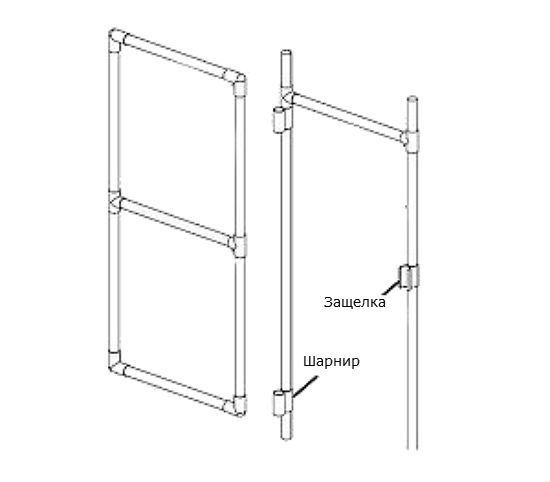
The one who takes the water collected by the solar cover in order to evacuate it and thus avoid flooding the plants. Solarium with 2-sided roof. The skeleton of this type of shelter is made of metal or wood, and the covering is made of either plastic film, or with removable panels. This is a very common and very sustainable solar energy.
Solar glass is also called greenhouse solarium, which is more complex design than the first three types, but not as common. However, it is clear to the naked eye that glass solariums are being replaced by those made of plastic film, which have many advantages for all vegetable growers: they are cheaper and easier to maintain. So, for a good investment, choose plastic foil tanning beds!
Scheme for assembling greenhouse doors from PVC pipes
Assembling the doors, you will need: 2 vertical parts, 2-2.1 m high, 3 transverse ones - 700-900 mm wide, connecting elements - 4 corners, 2 tees. The opening is made of 2 vertical posts, 1 diameter, as in the diagram above. The height and width of the opening should be 5-10 mm larger than the door itself. We attach hinges to one of the posts.
Starting from the representation of several companies, today we have a solid team of our partners with the most powerful, most advanced production lines for polymer products used in production plastic products. Using our experience, knowledge and strong production technical base, we can implement various production projects of polymer mixtures, various additives, paint and technical concentrates.
With excellent partners entrusted with a modern, certified engineering and laboratory facility, advanced scientific and technical personnel and a competent, field-qualified team of professionals, the company boldly and flexibly takes on the most complex challenges and challenges faced by a wide range of processes in the production of plastic products . Our sincere work, responsible, humane attitude towards the client and, of course, experience have allowed us to form relationships based on understanding, trust and responsibility between our partners and clients.
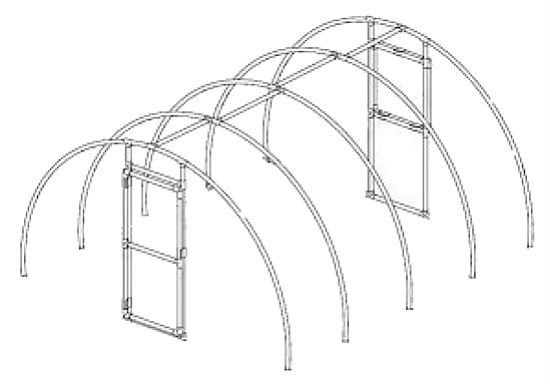
Simple scheme on which a greenhouse is assembled from PVC pipes with your own hands
Helpful advice: For the strength of the greenhouse, it is recommended to put an additional 1-2 tees on the front arch and secure them to them vertical racks and install horizontal stiffeners. The pediment can be made of wood or welded from metal profiled pipes.Along the long sidewall, from the outside of the foundation, we drive reinforcement, corrugated rods, 8-12 mm thick, into the ground to a depth of 300-700 mm, depending on the softness of the soil. The length of the rod is calculated individually, taking into account the fact that it should stick out 500-800 mm. The distance between the reinforcement is 600-900 mm, but not more than a meter.
While maintaining existing business ethics, using modern business schemes and tools, we are constantly expanding the range of activities, constantly adding products to the presented list, thereby ensuring continuity of the customer, a wide range, in accordance with the desired needs and requirements of the product range.
Our goal is mutually beneficial activity, in all situations remains a true professional. White concentrates are made from high quality titanium dioxide and have excellent dispersion, uniform distribution, stable and easy processing, and resistance to ultraviolet rays. A wide range of shades of white concentrates are available - from milky white to bluish tints. The wide range of products ensures a favorable price/quality ratio for every processing process and product.
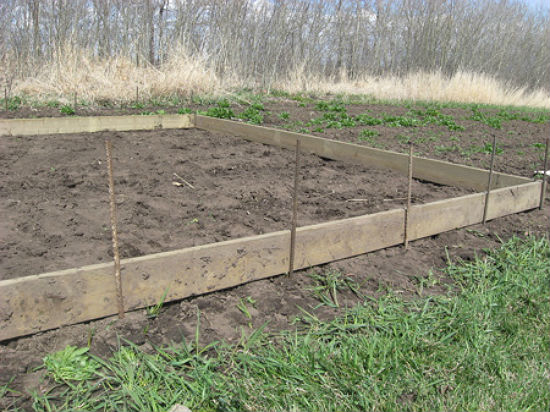
How to install a greenhouse from polyethylene pipes do it yourself, photo of the base with reinforcement for attaching the frame
We put a PVC pipe, cut to size, on one end of the rod, bend it, and insert the other end on the opposite side of the foundation. Using this algorithm we install the remaining arches.
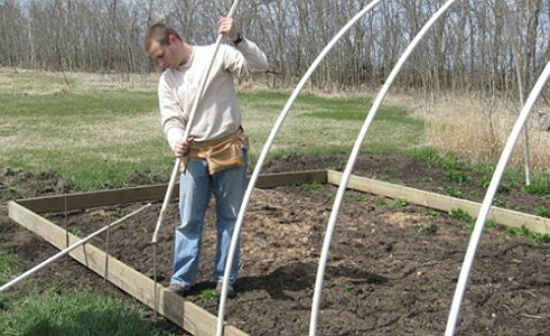
Thanks to the elasticity of PVC pipes, the arcs for the greenhouse are the same in shape
To installed greenhouse made of plastic pipes with our own hands was strong, we fasten the arcs to the foundation with galvanized brackets, which can be replaced with wide polymer clamps.
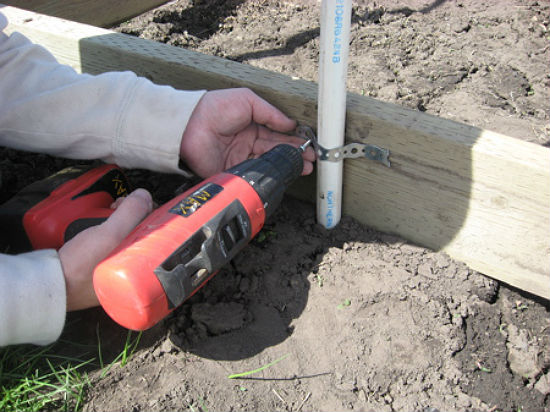
An example of how to assemble a greenhouse from plastic pipes with your own hands, photo of attaching the arcs to the base
In the same way we install the previously prepared gables of the greenhouse. It remains to connect the frame with transverse elements. We cut the PVC pipes along the length of the greenhouse, and fix them on the frame with plastic clamps, as in the photo below. One transverse element in the center of the greenhouse, at the highest point of the arc; in large buildings, it is advisable to add one more on each side.
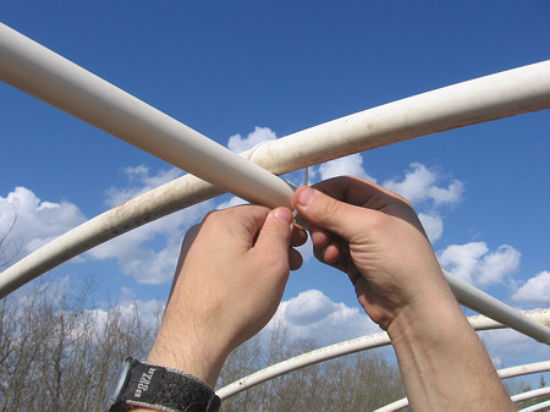
Greenhouse frame made of plastic pipes, in the photo how to attach longitudinal elements to clamps
According to the door assembly diagram, vents for ventilation are made and installed in the openings. Next, the frame is covered with plastic film.
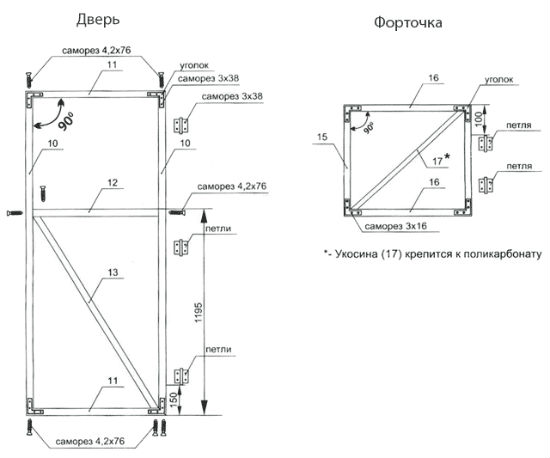
Assembly diagram of a reinforced version of doors and windows made of PVC pipes
Good to know: You can make hinges for opening openings yourself. To do this, cut 2 pieces of 10 mm each from a PVC pipe of larger diameter, glue them together, insert vertical elements of doors and vents into them, and fix them with self-tapping screws.Look at another option for assembling a small greenhouse with your own hands.
Other methods of constructing greenhouses from PVC pipes
A do-it-yourself arched greenhouse made of plastic pipes can be built entirely on connecting elements, but such structures will require large financial costs. Thanks to frequent sections, greenhouses made of PVC pipes with connectors are more durable.

One example of how to assemble greenhouses from polypropylene pipes with your own hands, in the photo the design is made with special connecting elements
A rectangular greenhouse made of PVC pipes is assembled in a similar way, but in this case, material with a diameter of 32-50 mm should be used.
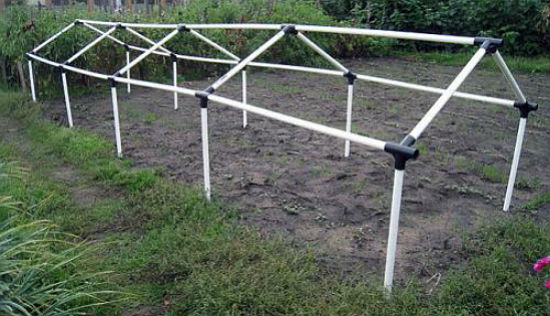
Greenhouse made of plastic pipes, the photo shows a typical gable design
How to attach film to frame
To attach the film to a frame made of PVC pipes, you can cut pieces of 50-100 mm, cut a quarter along the length, you get staples. After the film is stretched over the greenhouse, the resulting latches secure it to the vertical and longitudinal posts.
More ways to attach film to a greenhouse made of PVC pipes:
- mesh throughout the frame;
- ropes;
- on double-sided tape glued to the frame;
- Using strips cut from linoleum, fasten with ordinary self-tapping screws.
How to attach polycarbonate to a greenhouse frame made of PVC pipes
For a polycarbonate covering, it is recommended to make the greenhouse frame from PVC pipes with a diameter of 32 mm. Cellular sheets with a thickness of 4-6 mm are suitable.
The polycarbonate is fastened using self-tapping screws with a 3.2x25 mm press washer. The excess is cut off along an arc with a sharp knife. The second sheet is attached to overlap the first by 100 mm. You can also attach a special detachable docking profile to a frame made of PVC pipes with self-tapping screws, insert sheets into it, and close the joint with a plug.
Look at the reviews of the master who made a greenhouse from PVC pipes with polycarbonate with his own hands; in the video he explains the main stages of installation and mistakes that should be taken into account when constructing the structure.
Lately, in the countryside summer cottages very often you can see such a design as a compact and convenient prefabricated greenhouse made of polypropylene pipes. The enormous popularity of such structures among amateur gardeners is explained primarily by ease of use, reliability and low price. It will cost this lightweight design no more than 2 thousand rubles, but it will last quite a long time. For comparison: the cheapest ready-made prefabricated factory greenhouse costs at least 15,000 rubles from dealers.
How to build a greenhouse from polypropylene pipes: preparation of materials
You can assemble a classic arched PVC greenhouse with your own hands in just a couple of days. The following materials will be needed for its manufacture:
- PVC pipes intended for hot water supply are thick-walled (at least 4.2 mm). It is better to take a thicker option (with an internal diameter of at least 16.6 mm).
- Reinforcing rods are 75 cm long and 10-12 mm in diameter.
- Edged board 150*30 mm.
- Thin slats for attaching the film to the timber.
- Film for greenhouses reinforced or cellular polycarbonate.
- Beam 50*50 mm.
- Nails and screws.
You will also need to buy a couple of pipes of a larger diameter than the pipes prepared for the frame. They will be needed to make plastic latches for the film and door hinges.
A greenhouse is assembled from polypropylene pipes using the following tools:
- Hammer and drill.
- Garden auger or sledgehammer.
- A sharp painting knife.
Choosing a site for a greenhouse
Of course, this structure should be installed on sunny place, fairly well ventilated. You should not install a greenhouse where too much snow accumulates in winter. If the load is too great, the film may not withstand and tear. It is not necessary to comply with this condition only when the structure is planned to be dismantled for the winter. The area for the greenhouse should be as level as possible. The soil on it should be compacted a little.
Base assembly
So, let's start figuring out how to assemble a greenhouse from a polypropylene pipe with your own hands. Before installing its frame, you should carefully mark the selected area. The corners of the wooden frame made from boards must be absolutely straight. You can mark out the soil, for example, using the Egyptian triangle or “two curves” method.
The lower wooden frame is assembled using self-tapping screws or nails. After installation, a reinforcing rod should be inserted into each of its corners from the inside. This will avoid distortions during the frame assembly process.
Once the harness is ready, you can begin installing the important element base - reinforcing fastening rods. The easiest way to make holes for them is with a garden drill, since they must be deep enough (at least half a meter). You can also try hammering the rods with a regular sledgehammer or hammer. However, in this case it is more difficult to achieve absolute verticality.
The rods should protrude about 25 cm above the soil surface. They should be placed on both long sides of the future greenhouse in increments of 50 cm.
Frame assembly
After the base is ready, begin installing the “ribs” of the greenhouse. To do this, the pipes are simply put on the rods on both sides. The result is quite strong arches. At the next stage, polypropylene pipes should be reinforced with transverse stiffeners. They are also made from PVC pipes. The crossbars can be fixed either with wire or with plastic tees. In the latter case, the fittings are put on the arched ribs in advance. They can be soldered to the pipes, but it is better to use self-tapping screws for fastening. In this case, the greenhouse will be collapsible.
![]()
The number of transverse stiffeners depends on the size of the structure. However, even for a volumetric greenhouse, more than two or three are rarely used on each side. The only mandatory element of such a PVC design is the upper central transverse plastic “ridge”. Without this element, the film will sag after the first rain.
What does a greenhouse made of polypropylene pipes look like? Drawings and photos of such structures can be seen in the article.

Ends
These elements are assembled from timber, previously carefully treated with antiseptic anti-rot compounds. The film is attached to the timber using self-tapping screws through slats. If desired, the wood can be replaced with the same PVC pipes. In this case, sections of the required length are simply installed on the ends vertically along the edges of the future door. They can also be attached to the first arch with tees. At the bottom, fixation is carried out on reinforcing bars.
To the resulting plastic “jambs” you will need to attach a door assembled from segments. To do this, short sections of PVC pipe of larger diameter are soldered onto one of the vertical posts at the top and bottom. The door is placed on them.
Covering with film
A homemade greenhouse is sheathed from polypropylene pipes, usually with reinforced polyethylene. You should not use regular film for this purpose. Such cladding will not last especially long. It doesn't cost much more, but will last much longer.
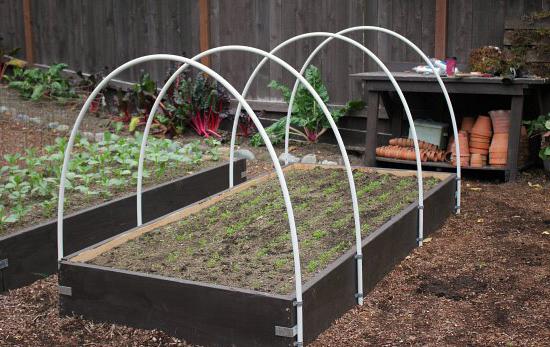
It is best to cut the sheathing directly into the greenhouse. In this way, inaccuracies can be avoided. The length of the stripes should be slightly longer than the length of the ribs of the “arches”. The fact is that at the final stage the film is usually tucked under the harness. You can also attach it to the tree through slats. It is fixed to the arched “ribs” with special plastic clips. The latter are made from short sections of larger diameter pipe. These tubes are simply cut, split lengthwise on one side into a narrow strip. The result is a comfortable elastic clamp.
Once the film is securely fastened, the assembly of the PVC greenhouse can be considered complete.
Other designs
Of course, greenhouses made of polypropylene pipes can have not only the classic arched shape. It is very easy to build, for example, a house structure from this material. Its assembly procedure consists of the following steps:
- The board strapping and fastening rods are mounted in exactly the same way as in the first case.
- Next, vertical pipe racks are installed on the reinforcement.
- Then plastic “rafters” are installed from identical sections.
- Connect them with ridge element through tees of the appropriate shape. The “rafters” are connected to the racks with fittings. At the top, each form should be reinforced with a horizontal cross member from a section of turbo.
- At the next stage, transverse stiffeners are mounted (also on tees pre-installed on the vertical posts).
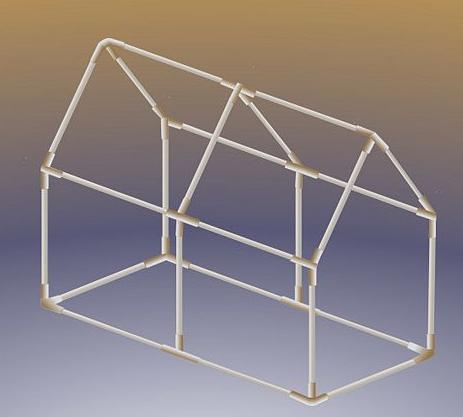
Use of polycarbonate
Greenhouses made of polypropylene pipes are sheathed not only with film. It is quite acceptable to replace it with a material that is also quite flexible and lightweight. It will last longer than film, but will also cost more. It should be attached to the pipes using roofing screws with thermal washers. Unlike reinforced film, polycarbonate can expand and contract when air temperature changes. Therefore, when using rigid fastenings, such cladding will quickly become unusable. The diameter of the holes for ordinary self-tapping screws in sheets should be slightly larger than their rods. In this case, a gap of approximately 1 mm should be left between the fastener head and the sheathing sheet.
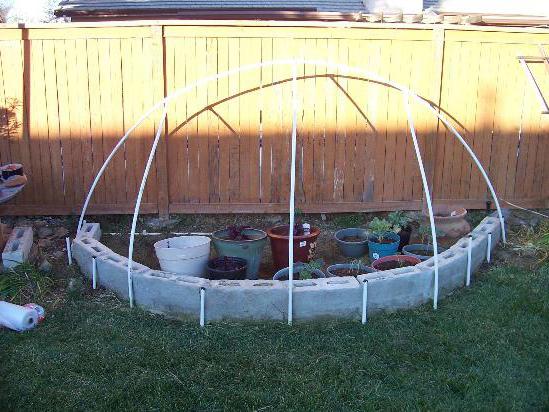
Polycarbonate is, of course, a very reliable and durable material. However, more often they are used to sheathe greenhouses on a frame made of a profile or corner. For plastic, budget film is usually still used.
How to care for a PVC greenhouse
As already mentioned, plastic construction It’s better to make it collapsible - with self-tapping screws. In this case, in the fall, after harvesting, it can simply be put away in the garage or outbuilding. If the greenhouse remains in the garden over the winter, snow will have to be periodically swept away from it. Otherwise, the film may not hold up and tear. Polycarbonate can withstand much greater loads. But you still have to remove a layer of snow from it. Otherwise, during the thaw, the casing will be covered with a thin crust of ice. Polycarbonate is absolutely scratch-resistant.

In the spring, the walls of the greenhouse with any type of cladding will need to be thoroughly washed with a soapy solution using a soft cloth.
As you can see, creating a greenhouse from pipes with your own hands is a very simple procedure. Assembly of such a structure takes little time. This light construction costs pennies. So, anyone can easily build a neat PVC greenhouse in their garden.
